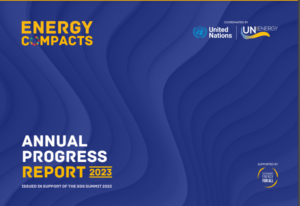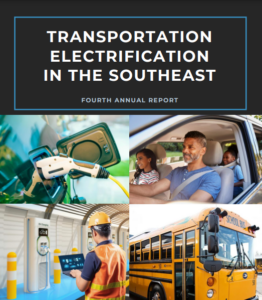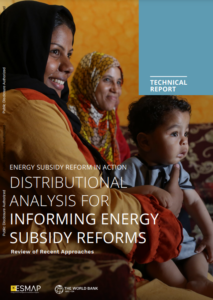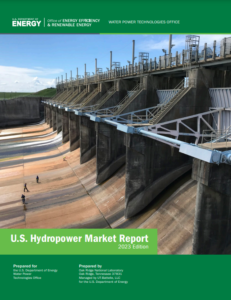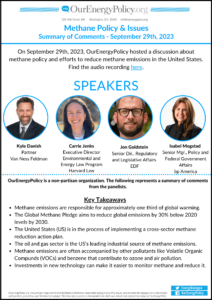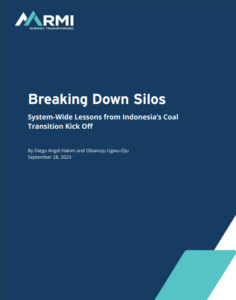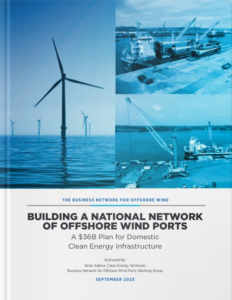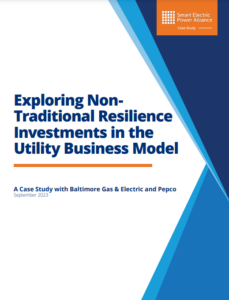The OurEnergyLibrary aggregates and indexes publicly available fact sheets, journal articles, reports, studies, and other publications on U.S. energy topics. It is updated every week to include the most recent energy resources from academia, government, industry, non-profits, think tanks, and trade associations. Suggest a resource by emailing us at info@ourenergypolicy.org.
Resource Library
In an era marked by unprecedented global challenges, from climate change to resource scarcity, energy has emerged as the critical lever that can either propel humanity toward a sustainable future or entrench us in the perils of environmental degradation and social insecurity. At the mid-point of the 2030 Agenda, as we stand at this critical juncture, we are delighted to introduce the Energy Compacts Annual Progress Report 2023, a testament to our collective determination to shape a brighter tomorrow.
As you will read in this report, the Energy Compact community has demonstrated unwavering commitment in responding to the UN Secretary-General’s …
View Full ResourceSince September 2020, Atlas Public Policy (Atlas) has partnered with the Southern Alliance for Clean Energy (SACE) to publish the annual Transportation Electrification in the Southeast report. This report benchmarks progress on transportation electrification in six states in the Southeast: Alabama, Florida, Georgia, North Carolina, South Carolina, and Tennessee. This is the fourth annual report and provides an update on progress from July 2022 through June 2023. A transition to electric transportation is underway across the country and with good policy design and implementation, may deliver emissions reductions resulting in improved public health along with jobs and economic development opportunities. …
View Full ResourceThis report aims to contribute to the global knowledge base on energy subsidy reform by exploring how poverty and distributional analyses have been used to support energy subsidy reform efforts. To this end, this report reviews select country-specific activities supported by the Energy Sector Management Assistance Program (ESMAP) and its Energy Subsidy Reform Facility (ESRF). The report begins by providing an overview of key distributional issues related to energy subsidy reforms and emerging lessons from a global stocktaking of practices, as well as country-specific insights from case studies. The report then discusses different approaches to the use of distributional analysis …
View Full ResourceFor most Americans, the mention of EVs conjures images of protected forests, composting, recycling, maybe a few affluent families who can afford to upgrade to a Tesla.
That’s a huge problem. These associations have allowed the far right to seize on EVs as a symbol for out-of-touch liberals trying to force a political agenda on working class families. They’ve become a cultural issue. And by continuing to present the benefits of EVs as exclusively environmental, the left is feeding that argument.…
Researchers at the U.S. Department of Energy’s (DOE) Water Power Technologies Office (WPTO) and Oak Ridge National Laboratory (ORNL) released a new report highlighting key developments across multiple sectors of the hydropower industry. The fourth edition of the U.S. Hydropower Market Report combines the latest data from public and commercial sources, as well as research findings from other DOE research and development projects, to provide a comprehensive picture of developments in the U.S. hydropower and pumped storage hydropower (PSH) fleet and industry trends. The report highlights developments from 2020-2022 (since the publication of the last report) and summarizes this information …
View Full ResourceOn September 29th, 2023, OurEnergyPolicy hosted a discussion about methane policy and efforts to reduce methane emissions in the United States. Read this event summary to learn more.…
View Full ResourceIn 2022, in collaboration with a team of partners, RMI advised the launch of a Just Energy Transition Partnership (JETP) focused on decarbonizing Indonesia’s electricity system. At $20 billion, the multilateral financial package was the largest yet assembled. The funds will help speed Indonesia’s transition to renewable sources away from coal.
To evaluate potential tradeoffs in the phaseout of coal, RMI developed a model that pairs detailed asset-level and corporate-financial analysis with a simple economic dispatch model, applying it to coal-generating units in Indonesia’s Java-Bali grid.
This insight brief includes an applied case of a plant-level analysis that holistically considers …
View Full ResourceThe Network’s report, Building a National Network of Offshore Wind Ports: A $36B Plan for Domestic Clean Energy Infrastructure highlights the urgent need for both public and private investment in the port infrastructure projects needed to meet the U.S.’s offshore wind power generation goals. Authored by Brian Sabina, CEO of Clean Energy Terminals and the Network’s Ports Working Group, the report lays out a $36 billion plan for developing domestic port infrastructure to help the U.S. reach its offshore wind deployment goals of 30 GW by 2030 and 110 GW by 2050. It offers practical cost and timing requirements for …
View Full ResourceThe Global Hydrogen Review is an annual publication by the International Energy Agency that tracks hydrogen production and demand worldwide, as well as progress in critical areas such as infrastructure development, trade, policy, regulation, investments and innovation.
The report is an output of the Clean Energy Ministerial Hydrogen Initiative and is intended to inform energy sector stakeholders on the status and future prospects of hydrogen. Focusing on hydrogen’s potentially major role in meeting international energy and climate goals, the Review aims to help decision makers fine-tune strategies to attract investment and facilitate deployment of hydrogen technologies at the same time …
View Full ResourceIn 2021-2022, Baltimore Gas & Electric (BGE) and Pepco Holdings Inc. (PHI) collaborated with the Smart Electric Power Alliance (SEPA) on a project focused on enhancing grid investment decisions with an emphasis on resilience and equity. The project aimed to identify grant opportunities and explore unconventional distribution upgrades. BGE and PHI were also engaged in efforts to strengthen grid infrastructure and implement innovative clean energy solutions to meet sustainability and resilience objectives at the state and utility levels in Maryland.…
View Full Resource